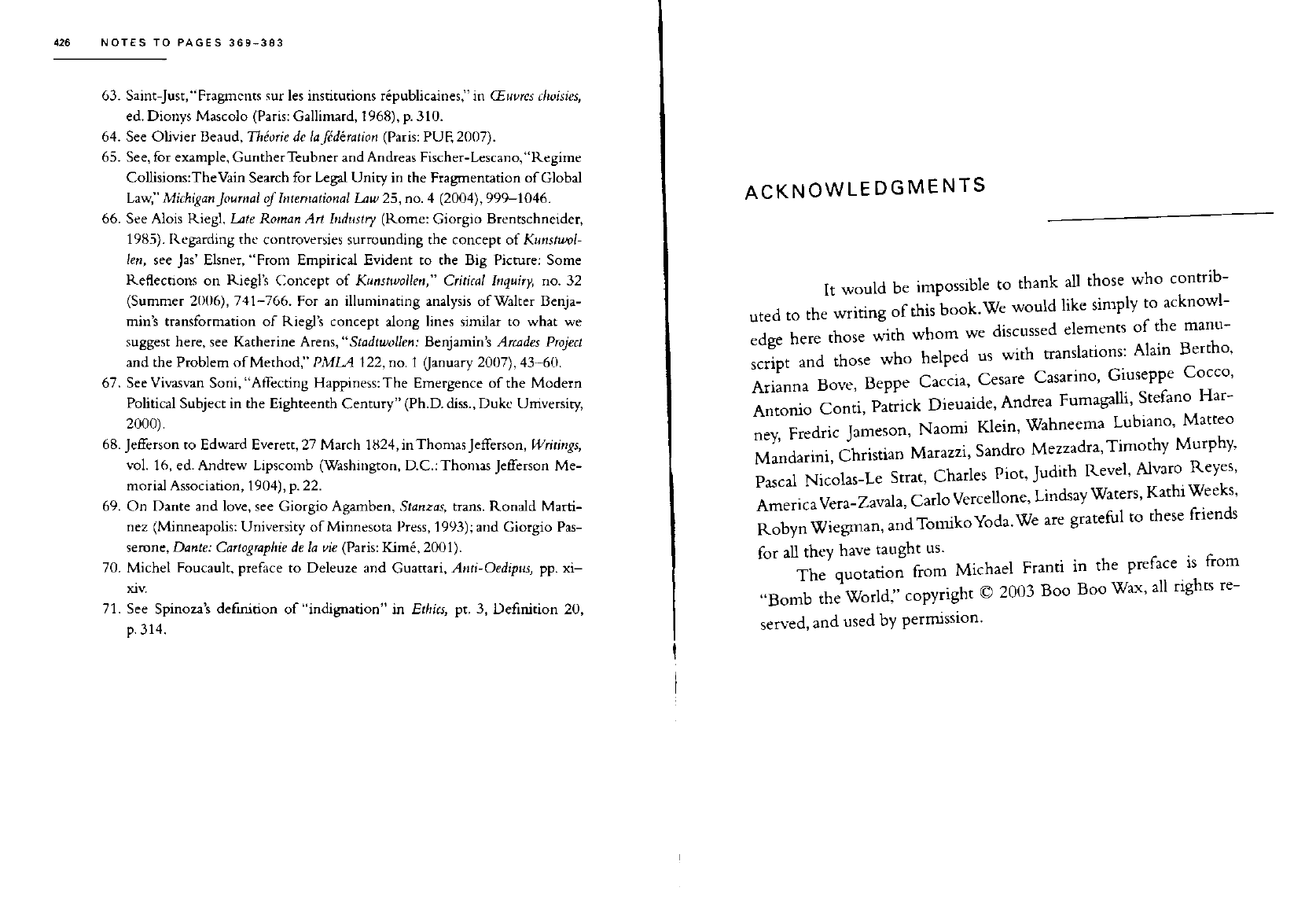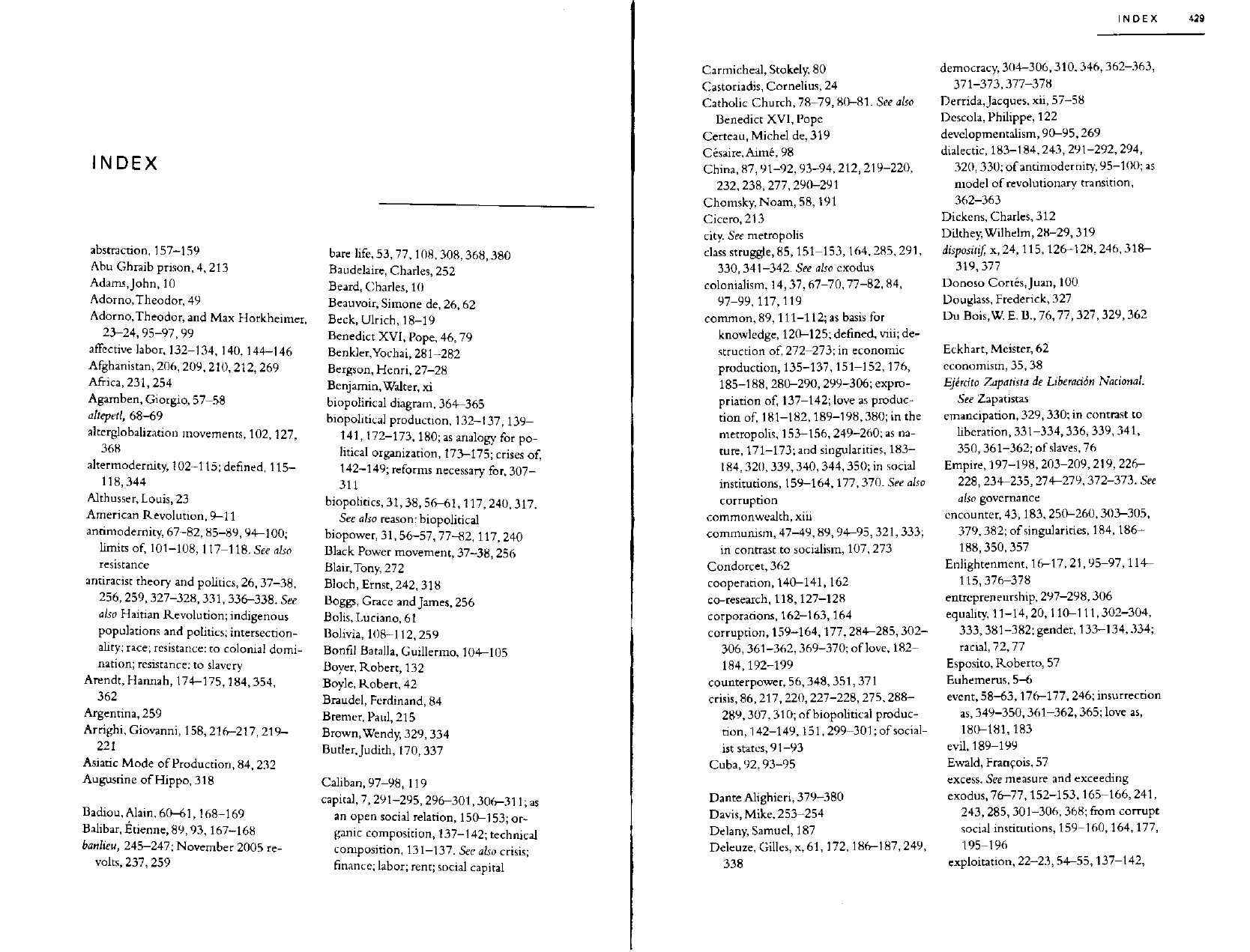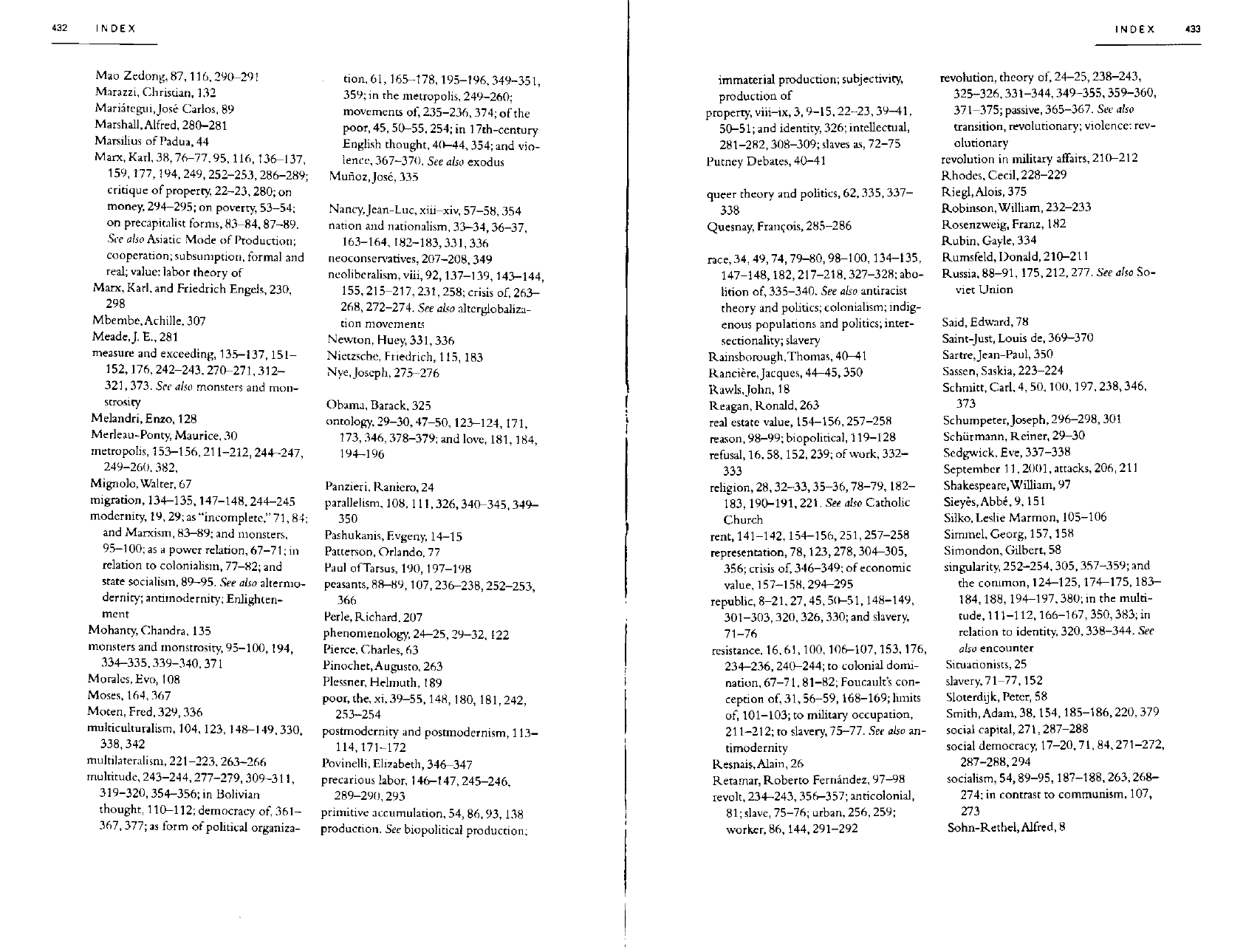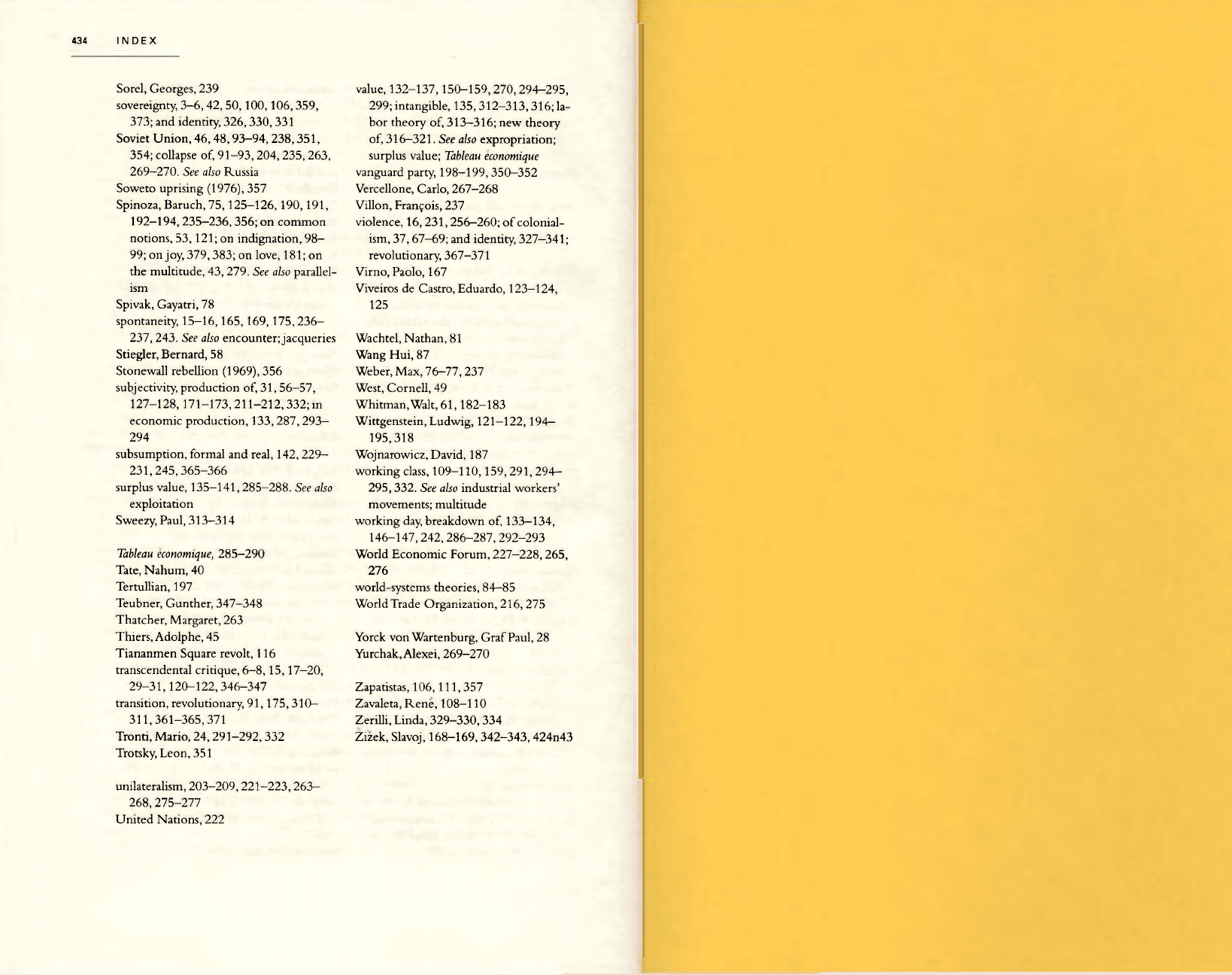Hardt Michael, Negri Antonio. Commonwealth
Подождите немного. Документ загружается.


424
NOTES
TO
PAGES 347-354
NOTES
TO
PAGES 356-369
425
34. Elizabeth
Povinelli,
The Cunning of Recognition:
Indigenous
Alterities and the
Making
of Australian Multiculturalism (Durham: Duke University Press,
2002).
35.
See Antonio
Negri,
"Lo
stato
dei partiti," in La forma
stato
(Milan:
Fel-
trinelli,
1977), pp. 111-149.
36.
See our presentation of contemporary positions regarding the crisis of de-
mocracy in the global context in
Michael
Hardt and Antonio
Negri,
Mul-
titude
(NewYork:
Penguin, 2004), pp. 231-37.
37.
Gunther Teubner, "Societal Constitutionalism: Alternatives to
State-
Centered Constitutional Theory?" in Transnational Governance and Consti-
tutionalism, ed. Christian Joerges,
Inger-Johanne
Sand, and GuntherTeub-
ner (Oxford: Hart, 2004), pp. 3-28.
38.
See
Alain
Supiot, Au-dela de
I'emploi
(Paris: Flammarion, 1999).
39.
Robin
Kelley
analyzes from a historical perspective a series of revolution-
ary alliances
that
border on insurrectional intersections in Freedom Dreams.
40.
Jacques
Ranciere, Disagreement,
trans.
Julie Rose (Minneapolis: University
of
Minnesota Press, 1999), p. 14.
41.
Jean-Paul Sartre, Critique of
Dialectical
Reason, vol. 1,
trans.
Alan
Sheridan-
Smith
(London:Verso, 2004).
42.
For
Lenin,
see primarily
What
Is to Be
Done?
(New
York:
International
Publishers,
1969). On
Lenin,
see also Antonio
Negri,
Lafabbrica della
strate-
gia: 33 lezioni su Lenin, 2nd ed. (Rome:
Manifestolibri,
2004); and Slavoj
Zizek,
ed., Revolution at the
Gates:
Ziiek on Lenin, the 1917 Writings
(Lon-
don:
Verso,
2004). For Trotsky, see The History of the Russian Revolution,
trans.
Max Eastman (New
York:
Simon & Schuster, 1932), esp. chap. 43,
"The Art of Insurrection."
43.
This periodization of vanguard
political
figures clarifies our difference
from
the propositions of Slavoj
Zizek
and Ernesto
Laclau.
Zizek's return
to
Lenin
is not so much a reversion to Lenin's method (designing
political
composition
on the basis
of
the current technical composition of the pro-
letariat) but, on the contrary, a repetition of the vanguard
political
forma-
tion
without reference to the composition of
labor.
Laclau
instead remains
faithful
to the conception of hegemony typical of the next
phase,
specifi-
cally
the one promoted by the Italian Communist Party in its populist
rather
than its workerist face.
44.
V.
I.
Lenin,
State
and Revolution
(NewYork:
International Publishers, 1971),
p.
43.
45.
On the development of communist movements in the 1970s, see
Negri,
Books
for Burning.
46.
Jean-Luc Nancy, "The Decision of Existence," in The Birth to Presence,
trans.
Brian
Holmes et al. (Stanford: Stanford University Press, 1993),
pp. 82-109.
47.
See
Michael
Hardt, "Thomas Jefferson, or, The Transition of Democracy,"
in
Thomas Jefferson, The Declaration of
Independence
(London:
Verso,
2007),
pp.
vii—xxv.
48.
See
Filippo
Del Lucchese,
Tumulti
e indignatio: Conflitto, diritto e moltitudine
in Machiavelli e Spinoza
(Milan:
Ghibli,
2004).
49.
Jean Genet, Prisoner of Love,
trans.
Barbara Bray (Hanover,
N.H.:
Univer-
sity
Press of New England, 1992).
50.
On
these
myths of network politics, see Carlo Formenti, Cybersoviet
(Mi-
lan:
Raffaele Cortina, 2008), pp. 201-264.
51.
On the
political
possibilities of network structures, see
Tiziana
Terranova,
Network Culture (London: Pluto, 2004); Geert
Lovink,
Uncanny
Networks
(Cambridge, Mass.: MIT Press, 2003);
Olivier
Blondeau, Devenir
media
(Paris:
Amsterdam, 2007); and Alexander Galloway and Eugene Thacker,
The Exploit
(Minneapolis:
University of Minnesota Press, 2007).
52.
Immanuel Kant, The Conflict of
Faculties,
trans.
Mary
Gregor
(Lincoln:
University
of
Nebraska Press, 1992), p. 153 (emphasis added).
53.
Ibid., p. 153.
54. Condorcet, "Sur le
sens
du mot revolutionnaire," in CEuvres de Condorcet,
ed.
A.
Condorcet and
F.
Arago,
12 vols. (Paris:
Firmin
Didot, 1847), 12:615.
See also Hannah Arendt, On Revolution (London: Penguin, 1963).
55.
W. E.
B.
Du
Bois,
Black Reconstruction
(NewYork:
Russell &
Russell,
1935),
p.
206.
56.
See primarily
Lenin,
State
and Revolution.
57.
For one version of the
argument
for the "autonomy of the
political,"
see
Mario
Tronti,
Sull'autonomia
del
politico
(Milan:
Feltrinelli,
1977).
58.
See Antonio Gramsci,
Selections
from
the Prison
Notebooks,
trans.
Quintin
Hoare and Geoffrey
Nowell
Smith
(NewYork:
International Books, 1971),
pp. 105-120 (on passive revolution) and pp. 279—318 (on Americanism
and Fordism).
59.
On the distinction between war of movement and war of position, see
ibid.,
pp. 229-235.
60.
Ibid., p. 286.
61.
We have addressed the question of revolutionary violence at various mo-
ments
in our
past
work, but our analysis in this book allows us to offer
some new insights. See
Negri,
Books
for Burning; and Hardt and
Negri,
Multitude, pp. 341-347.
62.
Jefferson to
William
Short, 3 January 1793, in Thomas Jefferson, Writings,
ed.
Merrill
Peterson
(New
York:
Library
of
America,
1984), p. 1004.

426
NOTES
TO
PAGES 369-383
63.
Saint-Just, "Fragments sur les institutions republicaines," in
CEuvres
choisies,
ed.
Dionys
Mascolo
(Paris:
Gallimard,
1968), p. 310.
64.
See
Olivier
Beaud, Theorie de la federation (Paris:
PUF,
2007).
65.
See, for example, GuntherTeubner and Andreas Fischer-Lescano/'Regime
Collisions:TheVain
Search for
Legal
Unity
in the Fragmentation of
Global
Law,"
Michigan
Journal of International Law 25, no. 4 (2004), 999-1046.
66.
See
Alois
Riegl,
Late
Roman
Art
Industry
(Rome:
Giorgio
Brentschneider,
1985). Regarding the controversies surrounding the concept of Kunstwol-
len, see Jas' Eisner,
"From
Empirical
Evident to the Big Picture: Some
Reflections
on Riegl's Concept of Kunstwollen,"
Critical
Inquiry, no. 32
(Summer 2006), 741-766. For an illuminating analysis
of
Walter
Benja-
min's transformation of Riegl's concept along lines
similar
to what we
suggest
here, see Katherine Arens, "Stadtwollen: Benjamin's Arcades Project
and the Problem of
Method,"
PMLA
122, no. 1 (January 2007), 43-60.
67.
SeeVivasvan
Soni,
"Affecting
Happiness: The Emergence of the Modern
Political
Subject in the Eighteenth Century"
(Ph.D.
diss., Duke University,
2000).
68.
Jefferson to Edward Everett, 27
March
1824, in Thomas Jefferson, Writings,
vol.
16, ed. Andrew Lipscomb (Washington,
DC:
Thomas Jefferson Me-
morial
Association,
1904), p. 22.
69.
On Dante and love, see
Giorgio
Agamben,
Stanzas,
trans.
Ronald
Marti-
nez
(Minneapolis:
University of
Minnesota
Press, 1993); and
Giorgio
Pas-
serone, Dante:
Cartographie
de la vie (Paris:
Kime,
2001).
70.
Michel
Foucault, preface to Deleuze and Guattari, Anti-Oedipus, pp. xi-
xiv.
71.
See Spinoza's definition of "indignation" in Ethics, pt. 3,
Definition
20,
p.
314.
ACKNOWLEDGMENTS
It
would
be
impossible
to
thank
all
those
who
contrib-
uted
to the
writing
of
this
book.
We
would
like
simply
to
acknowl-
edge
here
those
with
whom
we
discussed
elements
of the
manu-
script
and
those
who
helped
us
with
translations:
Alain
Bertho,
Arianna
Bove,
Beppe
Caccia,
Cesare
Casarino,
Giuseppe
Cocco,
Antonio
Conti,
Patrick
Dieuaide,
Andrea
Fumagalli,
Stefano
Har-
ney,
Fredric
Jameson,
Naomi
Klein,
Wahneema
Lubiano,
Matteo
Mandarini,
Christian
Marazzi,
Sandra
Mezzadra,
Timothy
Murphy,
Pascal
Nicolas-Le
Strat,
Charles
Piot,
Judith
Revel, Alvaro
Reyes,
America
Vera-Zavala,
Carlo
Vercellone,
Lindsay
Waters,
Kathi
Weeks,
Robyn
Wiegman,
andTomikoYoda.We
are
grateful
to
these
friends
for all
they
have
taught
us.
The
quotation
from
Michael
Franti
in the
preface
is
from
"Bomb
the World,"
copyright
©
2003
Boo Boo Wax, all
rights
re-
served,
and
used
by
permission.
•

INDEX
429
NDEX
abstraction, 157-159
Abu
Ghraib prison, 4, 213
Adams,
John,
10
Adorno.Theodor,
49
Adorno.Theodor,
and Max Horkheimer,
23-24,95-97,99
affective
labor, 132-134,140,144-146
Afghanistan,
206,209,210,212,269
Africa,
231,254
Agamben,
Giorgio,
57-58
altepetl,
68-69
alterglobalization
movements, 102,127,
368
altermodernity, 102-115; defined, 115-
118,344
Althusser,
Louis,
23
American
Revolution,
9-11
antimodernity, 67-82,85-89,94-100;
limits
of, 101-108,117-118.
See
also
resistance
antiracist theory and
politics,
26, 37-38,
256,259,327-328,331,336-338.
See
also
Haitian
Revolution;
indigenous
populations and
politics;
intersection-
ality;
race;
resistance:
to
colonial
domi-
nation;
resistance:
to slavery
Arendt,
Hannah, 174-175,184,354,
362
Argentina,
259
Arnghi,
Giovanni,
158,216-217,219-
221
Asiatic
Mode of
Production,
84, 232
Augustine
of
Hippo,
318
Badiou.Alain,
60-61,168-169
Balibar,
Etienne, 89,93, 167-168
banlieu,
245-247; November 2005 re-
volts,
237,259
bare
life,
53,77,108,308,368,380
Baudelaire,
Charles,
252
Beard,
Charles, 10
Beauvoir,
Simone de, 26,62
Beck,
Ulrich,
18-19
Benedict
XVI,
Pope, 46,79
Benkler.Yochai,
281-282
Bergson,
Henri,
27-28
Benjamin,
Walter,
xi
biopolitical
diagram, 364-365
biopolitical
production, 132-137, 139—
141,172-173,180; as analogy for po-
litical
organization,
173—175;
crises of,
142-149; reforms
necessary
for, 307-
311
biopolitics,
31,38,56-61,117,240,317.
See
also
reason:
biopolitical
biopower,
31,
56-57,77-82,117,240
Black
Power movement, 37-38,256
Blair,
Tony,
272
Bloch,
Ernst, 242,318
Boggs,
Grace and
James,
256
Bolis,
Luciano,
61
Bolivia,
108-112,259
Bonfil
Batalla,
Guillermo,
104-105
Boyer,
Robert, 132
Boyle,
Robert, 42
Braudel,
Ferdinand, 84
Bremer,
Paul,
215
Brown,
Wendy,
329,334
Buder,
Judith,
170,337
Caliban,
97-98, 119
capital,
7,291-295,296-301,306-311; as
an open
social
relation, 150-153; or-
ganic composition, 137-142; technical
composition,
131-137.
See
also
crisis;
finance;
labor;
rent;
social
capital
Carmicheal,
Stokely,
80
Castoriadis,
Cornelius,
24
Catholic
Church,
78-79,80-81.
See
also
Benedict
XVI,
Pope
Certeau,
Michel
de, 319
Cesaire,
Aime,
98
China,
87,91-92,93-94,212,219-220,
232,238,277,290-291
Chomsky,
Noam,
58,191
Cicero,
213
city.
See
metropolis
class struggle, 85,151-153,164,285,291,
330,341-342.
See
also
exodus
colonialism,
14,37,67-70,77-82,84,
97-99,117,119
common,
89, 111-112; as
basis
for
knowledge,
120—125;
defined,
viii;
de-
struction of, 272-273; in economic
production,
135-137,151-152,176,
185-188,280-290,299-306; expro-
priation
of, 137-142;love as produc-
tion
of, 181-182,189-198,380; in the
metropolis,
153-156,249-260; as na-
ture,
171-173; and singularities, 183—
184,320,339,340,344,350; in
social
institutions,
159-164, 177, 370.
See
also
corruption
commonwealth,
xiii
communism,
47-49,89,94-95,321,333;
in
contrast
to
socialism,
107, 273
Condorcet,
362
cooperation, 140-141, 162
co-research, 118,127-128
corporations, 162-163,164
corruption,
159-164,177,284-285,302-
306,361-362,369-370;
of
love,
182-
184,192-199
counterpower, 56,348,351,371
crisis,
86,217,220,227-228,275,288-
289,307,310;
of
biopolitical
produc-
tion,
142-149,151,299-301; of
social-
ist
states,
91-93
Cuba,
92,93-95
Dante
Alighieri,
379-380
Davis,
Mike,
253-254
Delany,
Samuel, 187
Deleuze,
Gilles,
x, 61,172,186-187,249,
338
democracy, 304-306,310,346,362-363,
371-373,377-378
Derrida,
Jacques,
xii,
57-58
Descola,
Philippe,
122
developmentalism, 90-95,269
dialectic,
183-184,243,291-292,294,
320,330;
of
antimodernity, 95-100; as
model
of
revolutionary
transition,
362-363
Dickens,
Charles,
312
Dilthey,
Wilhelm,
28-29,319
dispositif
x,
24,115,126-128,246,318-
319,377
Donoso
Cortes,
Juan, 100
Douglass,
Frederick, 327
Du
Bois.W.
E. B.,
76,77,327,329,362
Eckhart,
Meister,
62
economism,
35,38
Ejercito
Zapatista
de
Liberacion
Nacional.
See
Zapatistas
emancipation, 329, 330; in
contrast
to
liberation,
331-334,336,339,341,
350,361-362;
of
slaves, 76
Empire,
197-198,203-209,219,226-
228,234-235,274-279,372-373.
See
also
governance
encounter,
43,183,250-260,303-305,
379,382; of
singularities,
184,186-
188,350,357
Enlightenment, 16-17,21,95-97,114—
115,376-378
entrepreneurship,
297-298, 306
equality,
11-14,20, 110-111,302-304,
333,381-382;
gender,
133-134,334;
racial,
72,77
Esposito,
Roberto, 57
Euhemerus, 5—6
event,
58-63, 176-177, 246; insurrection
as, 349-350,361-362,365; love as,
180-181,183
evil,
189-199
Ewald,
Francois, 57
excess.
See
measure
and exceeding
exodus, 76-77,152-153,165-166,241,
243,285,301-306,368; from corrupt
social
institutions, 159-160, 164,177,
195-196
exploitation,
22-23,54-55,137-142,

430
INDEX
INDEX
431
exploitation
(continued)
309;
struggles
against,
319-320,235-
247
expropriation,
137-142; of the expropri-
ators,
329
externalities, 141,154-156,185-186,
251,280-283
family,
160-162,164,182-183,187
Fanon,
Frantz, 103-104,118,120,335-
336;
on nationalism and national
lib-
eration,
37,163
fascism,
4-5,20,27-28
Fausto-Sterling,
Anne,
170-171
federalism,
69, 379
feminist
theory and
politics,
26, 62,119,
170-171,329-330,334-335,337. See
also
gender;
intersectionality;
queer
theory and politics
feminization
of
work,
133-134,135,
146-147
Ferguson,
James,
231
Filmer,
Robert, 41-42
finance,
142,145, 156-158,289, 294-
295
Flaubert, Gustave, 244
force, 16-17,194-199,236,246-247,
267-271.
See
also
violence
Fordism
and
post-Fordism,
264, 272,
289-290,292,365-366
foreclosure
(in
psychoanalysis), 69-70,
74-75
forms
of
life,
81,121-124,194,354,356,
358,371;
production of, 131-133,175,
267,364
Foucault,
Michel,
x, 31,75,81-82,136-
137,172,191,224, 241,382; on
bio-
power and
biopolitics,
56—61;
on the
Iranian
Revolution,
35-36; on
reason
and knowledge, 119-120,121,126-
128
Fourier,
Charles, 177
Francis
of
Assisi,
43-44
freedom, 10-11,13-14,47-48,96,100,
101,
189, 234-236, 321; Foucault's
conception
of, 59-61, 81-82; and
identity,
37,329-336; required for
bio-
political
production, 282,289-290,
302-305,309-310; and
slavery,
72,75-
77. See
also
emancipation; liberation
Free Trade
Area
of the
Americas
(FTAA),
216
French
Revolution,
11-13,151,359-360,
369
Freud,
Sigmund,
62,194
Friedman,
Milton,
263
Friedman,Thomas, 213—214
Frum,
David,
207
Fukuyama,
Francis,
221
fundamentalism,
32-38
Garcia
Linera,
Alvaro,
110-111
Gates,
Bill,
297
Gates, Henry
Louis,Jr.,
49
gender,
62,133-135,160-161,170-171,
325-328; abolition of, 334-335,337-
340. See
also
feminist theory and
poli-
tics;
intersectionality
Genet, Jean, 187,356
Gentile,
Giovanni,
27-28
gentrification,
257-258
Giddens,
Anthony,
18-19,272
Gilroy,
Paul,
336-338
Gorz,
Andre,
132
governance, 223-228,274-279,347-348,
372-375
Gramsci,
Antonio,
365-368
Guantanamo, 4,213
guaranteed
basic income, 309-310
Guattari,
Felix,
172,186-187,249,338
Guevara,
Ernesto
(Che),
94-95,118
Guha,
Ranajit, 14,68,69
Haass,
Richard,
204-205
Habermas,Jurgen, 18,71
Haitian
Revolution,
13-14,74-75
Hamilton,
Charles, 80
happiness,
376-383
Haraway,
Donna, 120, 334
Harris,
Cheryl,
326
Harvey,
David,
231,266
hegemony, 167,169,173,175,304-305,
366. See
also
unilateralism
Heidegger,
Martin,
29-30,46-50,181
Hesse, Barnor, 80
heteronormativity, 160-161,328,335
Hobbes,Thomas, 4,41-42,51,189
Hoffman,
Danny, 146-147
humanity, creation of
a
new, 94,104,118,
336,361-362,366,369
human
nature,
52,196,353,361-362,
378;
pessimistic conceptions of, 11,
189-193,197-198
Huntington,
Samuel,
143
Hurricane
Katrina,
217-218
Husserl,
Edmund,
30
hypermodernity,
19,113
identity,
103-107,119-124,172,195,
320,347,348,358; and revolutionary
politics,
325-344,
371. See
also
singu-
larity
identity-blindness,
325,327-329,348
immaterial
production,
25,
132-133,258,
266. See
also
biopolitical
production;
property:
intellectual;
value: intan-
gible
imperialism,
86-87,203-209,219-220,
228,230.
See
also
Empire;
unilateralism
indigenous populations and
politics,
68—
69,79,89,104-112,123-124,328,
346—347.
See
also
colonialism
indignation,
235-243
industrial
workers' movements, 19,107—
111,121,237,241,250-259,291,364,
366
Inquisition,
Spanish, 80-81
institutions,
159-164,177-178,192-198,
284—285;
revolutionary notion of,
355-360,369-370,374-375.
See
also
governance
insurrection,
238-240,345,355-367
intellectuals,
role of, 103-104,118.
See
also
co-research
intersectionality,
340-344,345,349-350
Iranian
Revolution,
36
Iraq
War
(2003), 206,208,209-215,218,
220
jacqueries, 236—248
Jagose,
Annamarie,
335
Jefferson.Thomas, 9,139,310,355-356,
377,379; on
violence,
368-369
Jobs, Steve, 297
kairos,
165
Kant,
Immanuel,
xii,
6—8,15-17, 115,
190,346,359-360
Karl,
Rebecca, 232
katechon,
197-198
Kelley,
Robin,
128
Keynesjohn
Maynard,
141-142,306
Kissinger,
Henry, 221, 223
Klein,
Naomi,
137-138,215,231
knowledge as productive force, 145,267-
268,271,
281-282.
See
also
reason:
bio-
political
Krahl,
Hans-Jiirgen,
24—25
labor:
divisions
of, 73,135,160,228-230,
245;
increasing autonomy of, 150-151,
165,
173, 270,286-293; as poverty, 54;
and
slavery,
72-73; technical composi-
tion
of, 131-135, 352-354.
See
also
ex-
ploitation;
industrial
workers' move-
ments;
precarious labor;
value:
labor
theory of;
working
class
Laclau,
Ernesto, 166-167,304-305,
424n43
Latour,
Bruno,
124
laughter,
382-383
Lenin.Vladimir
Ilich,
90-91,175-176,
239,350-351,353,362-363; on impe-
rialism,
86-87,116
Leopardi,
Giacomo,
197
Levi-Strauss,
Claude,
122-123
liberation,
93-94,97-98,101-102,331-
344,349-350.
See
also
emancipation;
freedom
Liberia,
146-147
Locke,
John,
139,326
love,
xi-xii,
179-198,316,318,379-380;
gone
bad, 193-197; training in, 193-
195
Luhmann,
Niklas,
224,373
Luxemburg,
Rosa, 86,230,288
Macherey,
Pierre, 166, 176
Machiavelli,
Niccolo,
51-52,356
Macpherson,
C. B.,
240
Madison,
James,
11
Malcolm
X,
331,336
Mandeville,
Bernard, 148,184-186

432
INDEX
INDEX
433
Mao
Zedong, 87,116,290-291
Marazzi,
Christian,
132
Mariategui,Jose
Carlos,
89
Marshall,
Alfred,
280-281
Marsilius
of
Padua,
44
Marx,
Karl,
38,76-77,95,116,136-137,
159,177,194,249,252-253,286-289;
critique
of
property, 22-23, 280;
on
money, 294—295;
on
poverty, 53—54;
on
precapitalist forms, 83-84, 87-89.
See
also
Asiatic
Mode of
Production;
cooperation; subsumption, formal
and
real;
value:
labor theory
of
Marx,
Karl,
and
Friedrich
Engels, 230,
298
Mbembe.Achille,
307
Meade,J.E.,281
measure
and
exceeding, 135—137,151—
152,176,242-243,270-271,312-
321,
373.
See
also
monsters
and
mon-
strosity
Melandn,
Enzo,
128
Merleau-Ponty,
Maurice,
30
metropolis,
153-156,211-212,244-247,
249-260,382,
Mignolo,
Walter,
67
migration,
134-135,147-148,244-245
modernity, 19,29; as "incomplete,"
71,
84;
and
Marxism,
83—89;
and
monsters,
95—100;
as
a
power relation,
67—71;
in
relation
to
colonialism,
77-82; and
state
socialism,
89-95.
See
also
altermo-
dernity; antimodernity;
Enlighten-
ment
Mohanty,
Chandra,
135
monsters
and
monstrosity, 95-100,
194,
334-335,339-340,371
Morales,
Evo,
108
Moses,
164,367
Moten,
Fred,
329,336
multiculturalism,
104,123,148-149,330,
338,342
multilateralism,
221-223,263-266
multitude, 243-244,277-279,309-311,
319-320, 354-356; in
Bolivian
thought,
110-112; democracy of, 361-
367,
377; as form of
political
organiza-
tion,
61,165-178,195-196,349-351,
359;
in
the
metropolis, 249-260;
movements
of, 235-236,374;
of
the
poor, 45, 50-55, 254; in
17th-century
English
thought,
40-44, 354; and
vio-
lence, 367-370.
See
also
exodus
Muiioz,Jose,
335
Nancy,
Jean-Luc,
xiii—xiv,
57—58,354
nation
and
nationalism, 33-34,36—37,
163-164,182-183,331,336
neoconservatives, 207-208,349
neoliberalism,
viii,
92,137-139,143-144,
155,215-217,231,258; crisis
of,
263-
268,
272—274.
See
also
alterglobaliza-
tion
movements
Newton,
Huey,
331,336
Nietzsche,
Friedrich,
115,
183
Nye,
Joseph, 275-276
Obama,
Barack,
325
ontology,
29-30,47-50,123-124,171,
173,346,378-379; and
love,
181,184,
194-196
Panzieri,
Raniero,
24
parallelism,
108,111,326,340-345,349-
350
Pashukanis,
Evgeny,
14—15
Patterson,
Orlando,
77
Paul
of
Tarsus, 190,197-198
peasants,
88-89,107,236-238,252-253,
366
Perle,
Richard,
207
phenomenology, 24-25,29-32,122
Pierce,
Charles,
63
Pinochet,
Augusto,
263
Plessner, Helmuth,
189
poor, the,
xi,
39-55,148,180,181,242,
253-254
postmodernity
and
postmodernism, 113—
114,171-172
Povinelli,
Elizabeth,
346-347
precarious labor, 146-147, 245-246,
289-290,293
primitive
accumulation, 54, 86,93,
138
production.
See
biopolitical
production;
immaterial
production; subjectivity,
production
of
property,
viii-ix,
3,9-15,22-23,39-41,
50-51;
and
identity, 326; intellectual,
281-282,308-309; slaves as, 72-75
Putney
Debates,
40-41
queer
theory
and
politics,
62,335,337-
338
Quesnay,
Francois,
285-286
race,
34,49,74,79-80,98-100,134-135,
147-148,182,217-218,327-328; abo-
lition
of, 335-340.
See
also
antiracist
theory
and
politics;
colonialism;
indig-
enous
populations
and
politics;
inter-
sectionality;
slavery
Rainsborough,
Thomas,
40-41
Ranciere,
Jacques,
44-45,350
Rawlsjohn,
18
Reagan,
Ronald,
263
real
estate
value, 154-156,257-258
reason,
98-99;
biopolitical,
119-128
refusal,
16,58,152,239;
of
work,
332-
333
religion,
28,32-33,35-36,78-79,182-
183,190-191,221.
See
also
Catholic
Church
rent,
141-142,154-156,251,257-258
representation,
78,123,278,304-305,
356;
crisis
of, 346-349; of economic
value,
157-158,294-295
republic,
8-21,27,45,50-51,148-149,
301-303,320,326,330;
and
slavery,
71-76
resistance,
16,61,100,106-107,153,176,
234-236,240-244;
to
colonial
domi-
nation,
67-71,81-82; Foucault's con-
ception
of,
31,56-59,168-169;
limits
of, 101-103;
to
military occupation,
211-212;
to
slavery, 75-77.
See
also
an-
timodernity
Resnais,
Alain,
26
Retamar, Roberto Fernandez,
97-98
revolt,
234-243, 356-357;
anticolonial,
81;
slave,
75-76; urban, 256,259;
worker,
86,144,291-292
revolution,
theory of, 24-25, 238-243,
325-326,331-344,349-355,359-360,
371-375;
passive, 365-367.
See
also
transition,
revolutionary;
violence:
rev-
olutionary
revolution
in
military affairs, 210-212
Rhodes,
Cecil,
228-229
Riegl,
Alois,
375
Robinson,
William,
232-233
Rosenzweig,
Franz,
182
Rubin,
Gayle,
334
Rumsfeld,
Donald,
210-211
Russia,
88-91,175,212,277.
See
also
So-
viet
Union
Said,
Edward,
78
Saint-Just,
Louis
de, 369-370
Sartre,
Jean-Paul,
350
Sassen,
Saskia,
223-224
Schmitt,
Carl,
4,50,100,197,238,346,
373
Schumpeterjoseph, 296-298,301
Schurmann, Reiner, 29-30
Sedgwick,
Eve,
337-338
September
11,2001,
attacks,
206,211
Shakespeare,
William,
97
Sieyes,Abbe,9,151
Silko,
Leslie
Marmon,
105-106
Simmel,
Georg, 157,158
Simondon,
Gilbert,
58
singularity,
252-254,305,357-359;
and
the
common, 124-125,174-175,183-
184,188,194-197,380; in
the
multi-
tude,
111-112,166-167,350,383; in
relation
to
identity, 320,338-344.
See
also
encounter
Situationists,
25
slavery,
71-77,152
Sloterdijk,
Peter,
58
Smith,
Adam,
38,154,185-186,220,379
social
capital,
271,287-288
social
democracy, 17-20,71,84,271-272,
287-288,294
socialism,
54,89-95,187-188,263,268-
274; in
contrast
to
communism, 107,
273
Sohn-Rethel,
Alfred,
8

434
INDEX
Sorel,
Georges, 239
sovereignty, 3-6,42,50,100,106,359,
373;
and identity, 326,330,331
Soviet
Union,
46,48,93-94,238,351,
354; collapse of, 91-93,204,235,263,
269-270.
See
also
Russia
Soweto uprising (1976), 357
Spinoza,
Baruch,
75,125-126,190,191,
192-194, 235-236,356; on common
notions, 53,121; on indignation, 98-
99;
on
joy,
379, 383; on love, 181; on
the multitude, 43, 279.
See
also
parallel-
ism
Spivak,
Gayatri,
78
spontaneity,
15-16,165,169,175,236-
237,243.
See
also
encounter;
jacqueries
Stiegler,
Bernard, 58
Stonewall
rebellion (1969), 356
subjectivity,
production of, 31, 56—57,
127-128,171-173,211-212,332; in
economic production, 133, 287,
293—
294
subsumption, formal and real, 142, 229-
231,245,365-366
surplus value, 135-141, 285-288.
See
also
exploitation
Sweezy,
Paul,
313-314
Tableau
economique,
285-290
Tate, Nahum, 40
Tertullian,
197
Teubner, Gunther, 347-348
Thatcher, Margaret, 263
Thiers,
Adolphe,
45
Tiananmen
Square
revolt, 116
transcendental
critique, 6-8,15,17—20,
29-31,120-122,346-347
transition, revolutionary, 91,175,310—
311,361-365,371
Tronti,
Mario,
24,291-292,332
Trotsky,
Leon,
351
value, 132-137,150-159,270,294-295,
299;
intangible, 135, 312-313, 316;
la-
bor theory of, 313-316; new theory
of, 316—321.
See
also
expropriation;
surplus value;
Tableau
economique
vanguard party, 198-199, 350-352
Vercellone,
Carlo,
267-268
Villon,
Francois, 237
violence,
16,231,256-260; of
colonial-
ism,
37, 67-69; and identity, 327-341;
revolutionary,
367—371
Virno,
Paolo, 167
Viveiros
de Castro, Eduardo, 123-124,
125
Wachtel,
Nathan, 81
Wang
Hui,
87
Weber,
Max,
76-77,237
West,
Cornell,
49
Whitman,
Walt,
61,182-183
Wittgenstein,
Ludwig,
121-122, 194-
195,318
Wojnarowicz,
David,
187
working
class, 109-110,159,291,294-
295,
332.
See
also
industrial workers'
movements; multitude
working
day, breakdown of, 133-134,
146-147,242,286-287,292-293
World
Economic Forum, 227-228, 265,
276
world-systems
theories,
84—85
World
Trade Organization, 216, 275
Yorck
von
Wartenburg,
Graf
Paul,
28
Yurchak,Alexei,
269-270
Zapatistas, 106, 111,357
Zavaleta,
Rene, 108-110
Zerilli,
Linda,
329-330,334
Zizek,
Slavoj,
168-169,342-343,424n43
unilateralism,
203-209, 221-223, 263-
268,275-277
United
Nations, 222
